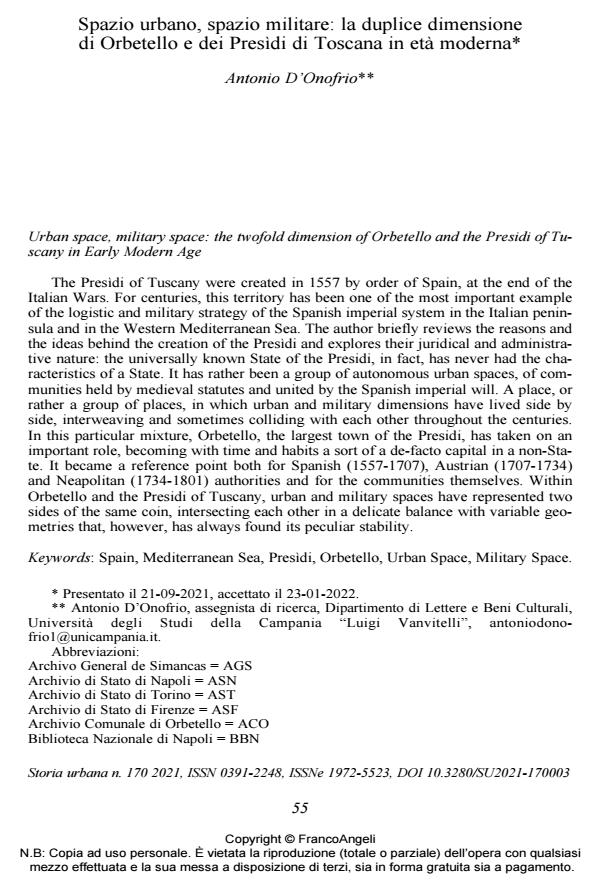Urban space, military space: the twofold dimension of Orbetello and the Presidi of Tuscany in Early Modern Age
Journal title STORIA URBANA
Author/s Antonio D’Onofrio
Publishing Year 2021 Issue 2021/170
Language Italian Pages 17 P. 55-71 File size 209 KB
DOI 10.3280/SU2021-170003
DOI is like a bar code for intellectual property: to have more infomation
click here
Below, you can see the article first page
If you want to buy this article in PDF format, you can do it, following the instructions to buy download credits

FrancoAngeli is member of Publishers International Linking Association, Inc (PILA), a not-for-profit association which run the CrossRef service enabling links to and from online scholarly content.
The Presìdi of Tuscany were created in 1557 by order of Spain, at the end of the Italian Wars. For centuries, this territory has been one of the most important example of the logistic and military strategy of the Spanish imperial system in the Italian peninsula and in the Western Mediterranean Sea. The author briefly reviews the reasons and the ideas behind the creation of the Presìdi and explores their juridical and administrative nature: the universally known State of the Presidi, in fact, has never had the cha racteristics of a State. It has rather been a group of autonomous urban spaces, of com munities held by medieval statutes and united by the Spanish imperial will. A place, or rather a group of places, in which urban and military dimensions have lived side by side, interweaving and sometimes colliding with each other throughout the centuries. In this particular mixture, Orbetello, the largest town of the Presidi, has taken on an important role, becoming with time and habits a sort of a defacto capital in a nonState. It became a reference point both for Spanish (1557-1707), Austrian (1707-1734) and Neapolitan (1734-1801) authorities and for the communities themselves. Within Orbetello and the Presidi of Tuscany, urban and military spaces have represented two sides of the same coin, intersecting each other in a delicate balance with variable geo metries that, however, has always found its peculiar stability.
Entità territoriale creata per volere della Spagna nel 1557, al termine delle Guerre d’Italia, i Presìdi di Toscana sono stati per secoli una delle più importanti espressioni della strategia logistico-militare del sistema imperiale spagnolo nella penisola italiana e nel Mediterraneo occidentale. L’articolo ripercorre dapprima i presupposti che porta- rono alla creazione dei Presìdi e ne indaga la natura giuridica e amministrativa: quello che è universalmente noto come Stato dei Presìdi, infatti, non ha mai posseduto le ca- ratteristiche di uno Stato, ma è stato piuttosto un insieme di spazi urbani autonomi, co- munità rette da statuti medievali unite dalla volontà imperiale spagnola. Un luogo, o meglio un insieme di luoghi, in cui dimensione urbana e militare hanno vissuto l’una accanto all’altra, intrecciandosi e talvolta scontrandosi nel corso dei secoli. In questa particolare commistione, ha assunto un ruolo rilevante il centro più grande dei Presìdi, Orbetello, diventato con il tempo e le consuetudini una capitale de facto all’interno di un non-stato, punto di riferimento tanto per le autorità spagnole (1557-1707), austria- che (1707-1734) e napoletane (1734-1801), quanto per le stesse comunità. In Orbetel lo e nei Presìdi di Toscana, spazio urbano e spazio militare hanno rappresentato due facce della stessa medaglia, intersecate tra loro in un delicato equilibrio che, tuttavia, ha sempre trovato una sua peculiare stabilità.
Keywords: Spain, Mediterranean Sea, Presìdi, Orbetello, Urban Space, Military Space
Antonio D’Onofrio, Spazio urbano, spazio militare: la duplice dimensione di Orbetello e dei Presìdi di Toscana in età moderna in "STORIA URBANA " 170/2021, pp 55-71, DOI: 10.3280/SU2021-170003